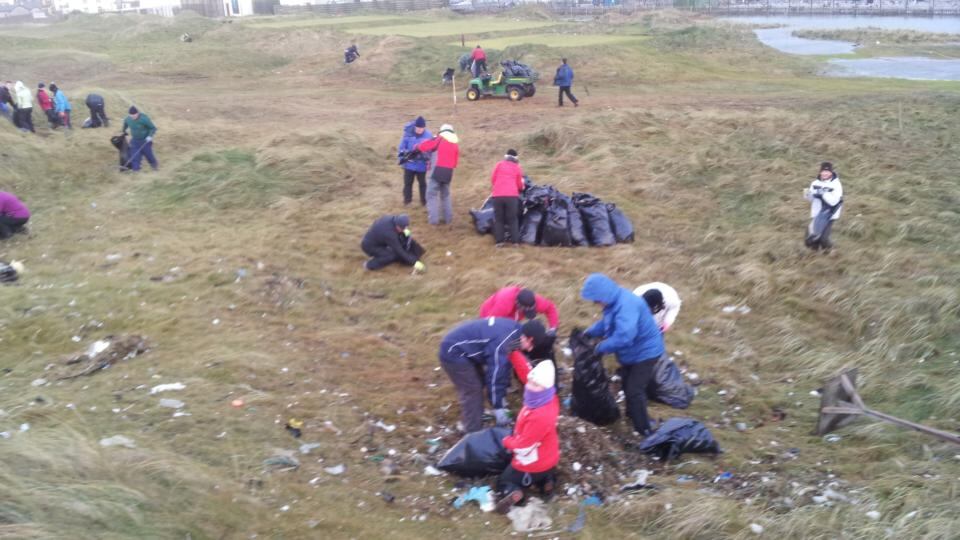No silver lining just yet, not for a large number of golf courses which felt the brunt of the recent Atlantic storms. Although many greenkeepers and officials offered silent prayers in thanks to whoever invented the defence mechanism against coastal erosion that has become known as “rock armour”, which – in some cases – limited the damage and resulted in a fallout of nothing worse than debris, litter and rocks that a good, old-fashioned all-hands-on-deck clean-up could sort out, other courses weren’t so fortunate.
Doonbeg, the acclaimed links in Co Clare designed by Greg Norman, and Co Sligo Golf Club at Rosses Point, the traditional home of the West of Ireland amateur championship, suffered damage to the dune complexes as the combination of high tides and storm force winds took a toll. The back tee – one of four – on the 18th hole at Doonbeg was swept away. "At least we still have another three (tee boxes) there," remarked Joe Russell, the managing director, in taking a philosophical view.
The saving grace for many affected courses – among them Ballybunion, Dooks and Tralee – was that rock armour has, over the past number of decades, been erected along the shoreline as measures against coastal erosion.
0 of 4
As Michéal Shanahan, the course superintendent at Dooks put it, "we escaped because of the work done in putting in rock armour in the 80s and 90s and more in recent years . . . the erection of the rock armour is protecting the nature of the dunes, it has proven to be environmentally friendly because, if it wasn't there, I'd estimate large parts of dunes would have been swept away. We'd have lost the guts of nine holes."
Coastal erosion
Ballybunion, which has had a history of coastal erosion down the years until a concerted programme of protection in the form of rock armour and gabions (rocks encased in metal netting) was formalised. The cost of such protection down the years has run into many millions of euro but its effectiveness was demonstrated in recent weeks with its ability to withstand the Atlantic storms. Apart from some debris and rocks on the 16th and 17th holes – "which will require a bit of cleaning up", according to general manager Vari McGreevy – the damage was limited.
Likewise in Tralee, the effectiveness of the rock armour limited any serious erosion. “It’s only minor, in comparison to what it could have been,” said a relieved course superintendent JJ Young.
In Waterville, the club's general manager Noel Cronin was also thankful for the effectiveness of the rock armour. "We had a major job done about 10 years, it has been wonderful. We're very lucky," he said.
Unfortunately for Doonbeg, it is not permitted – the links designed by the Great White Shark being built on an area of special conservation – to have similar rock armour erected along its dune complexes.
The signature par-three 14th hole at Doonbeg – perilously perched over the Atlantic and already one of the more famed short holes in global golf – survived, thankfully, although Russell said work would be required. Apart from the loss of the back tee on the 18th, a segment of the fairway was also lost there to the elements.
"Each winter, over the past 10 years, we have to deal with what comes in off the ocean . . . and there is no doubt this is the hardest hit (taken)," said Russell, who added that the necessary repair work would be undertaken in time for the important golf tourist season ahead. Indeed, despite the effects of the storms, the links remained open and there was golf traffic on the links yesterday.
Western seaboard
Up and down the western seaboard, a large number of golf courses continue to be involved in clean-up operations.
On the old course at Lahinch, over 100 volunteers yesterday filled more than 500 black bags with rubbish – everything from a dead fish to litter and seaweed – and will return again today to finish the job at hand. The worst affected area was the third hole, which runs close to the promenade where giant waves caused structural damage but only resulted in flooding on the golf course.
The four holes closest to the sea at Galway Golf Club – where general manager Páraic Fahy estimated some 212 tonnes of stones and sand was dumped onto the course following the storm – will likely remain closed until next week, as a major clean-up operation is undertaken.
The situation at Rosses Point, however, is rather more serious with general manager David O’Donovan estimating the repair work could cost up to €200,000 after the rock barrier by the 17th fairway was breached resulting in a two and half metres chunk of land disappearing and which has left the sea “too close for comfort” to the links. Some 2,000 square metres of dunes – land reclaimed in the past 20 years – by the 13th and 14th holes was also lost to the elements inside the last week.
More worrying for all at Rosses Point, the subsequent tides have militated against early repair work to protect the 17th from the sea and unable to get rock and sand back into the exposed area.

















